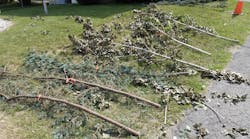Researching Branch Strikes
Experimental Method
Structure Geometry
- Three variations of the new distribution line design standard were provided by Xcel Energy, each having a different center-phase height.
- The position of the middle phase above the crossarm depicted in the first figure on the facing page was used in the initial round of tests.
- The middle phase was elevated in the second round of tests (+8 in.) and raised further (+16 in.) above the crossarm in the final round of branch drop tests. Phase spacings were derived from the design drawings to determine voltage gradients between conductors.
Test Setup
EPRI built a test span at EPRI’s Lenox test facility. Linemen framed the two structures on either end of the test span and tensioned the conductors per the design standard provided by Xcel Energy. The utility also supplied the materials used to fabricate the structures and span. Once initially framed, shown in photo above, the location of the middle phase was altered in each of two subsequent rounds of tests.
Branch strike testing involved dropping branch specimens on the test span of overhead distribution line. The protocol started with 10 tests for each of the two branch types being used. If all 10 tests of a set resulted in the same outcome, the test was terminated; if not, an additional ten (N=20) drops were performed.
Branch drops were from 15 ft above the static shield conductor. The basket on the aerial lift was generally positioned 72 in. away from Center Line (C/L) of the design (the neutral conductor). The Center of Gravity (CG) was marked with flagging ribbon. Each drop was controlled for the position of conductor strike to the neutral (C/L) relative to the CG. Previous EPRI research demonstrated how branch rotation imparted due to conductor impact affects the likelihood of retention. This is a function of where along the branchthe strike occurs relative to its center of mass and whether the strike occurs on one or multiple conductors at nearly the same time.
In this project, branch drop tests were performed from each side of each design. Each side of each design was subjected to branches that had abias to fall away butt first (“with the grain”) and tip first (“against the grain”).
- Butt first = Center of Gravity
(CG) of branch strike with
neutral on side being evaluated. - Tip first = Center of Gravity
(CG) of branch strike with
neutral on opposite side of
what is being evaluated.
Findings
Test results demonstrated a difference between the three designs in terms of the likelihood of a falling branch being captured and remaining in contact with conductors, as shown in the chart to the left, includes comparative data from previous testing to illustrate the relative performance of the Xcel Energy design.
The highest number of branches that fell clear happened on the side of the structure that did not include the center-phase conductor. However, the configuration with the lowest number of phase-to-phase captures included the center phase located at its highest position, 16 in. above the crossarm. This conductor configuration created a sloped geometry that the branch could slide off of.
General Observations
As a result of this project, a number of observations were made, including:
- The dynamic motion imparted on branches with CGs not aligned with the shield wire upon impact was significant. The elevated position of the neutral helped initiate rotation. That was consistent with previous EPRI research. This increased rotation made it more likely that the branch would fall clear. In many cases, branches that fell clear slid by and between conductors with limited potential of only making intermittent contact with phases as they fell away. This was due to the increased phase-phase spacing.
- The importance of branch length was demonstrated repeatedly. Shorter branches were less likely to be captured by these designs.
- The importance of considering branch architecture was clearly demonstrated over the course of this work. The loss of lateral branches over the course of a series of branch drops resulted in a branch being less likely to be retained. It is important also to recognize that branch architecture would vary within species and between species. Ponderosa and lodge pole pine perform differently than blue spruce.
Identifying Phase Configurations
Branches that remain in contact with conductors can create a high-impedance fault. If the voltage gradient between areas of unequal potential is high enough, the pathway may evolve into a low-impedance path, resulting in a high-current fault and a subsequent interruption or outage. Utilities that experience outages caused by branches should consider identifying phase configurations designed to reduce the likelihood of branch retention. This approach could be especially helpful for utilities in high-risk wildfire locations.
Xcel Energy optimized one design through laboratory testing that demonstrated how shifting the location of one phase affects branch retention. By creating a sloped conductor configuration, Xcel reduced the observed number of phase-to-phase branch retention outcomes from 15% to 11%. This project demonstrated the importance of considering phase spacing and orientation when evaluating the vulnerability of overhead multi-phase distribution lines to tree strikes.
Editor’s Note: For more information on this project, and similar research conducted by EPRI, visit: https://distribution.epri.com/resources/applications/structure-testing/
John Goodfellow ([email protected]) has 40 years of experience in the utility industry and is an authority on utility vegetation management and reliability. He currently manages an active portfolio of vegetation management related research projects and serves as the chair of the Right of Way Steward Council’s Technical Advisory Committee, which established accreditation requirements for IVM on electric transmission and pipeline systems in North America. He is the lead author of the new ISA BMP Utility Tree Risk Assessment (2019).
Dr. Joe Potvin ([email protected]) is a senior project manager at the Electric Power Research Institute (EPRI) and leads overhead distribution
asset research. His research activities focus on improving the reliability and resiliency of overhead distribution systems through enhanced line design
and equipment performance. Dr. Potvin is currently investigating structural failure mechanisms of overhead power distribution systems. This work is
identifying areas of mechanical weakness as well as causes of prolonged outages and improving upon the processes and devices used in restoration. Dr. Potvin received BS, MS, and PhD degrees in electrical engineering from Clarkson University in Potsdam, New York.
David Flaten ([email protected]) works in the Electric Distribution Standards Department for Xcel Energy. He earned his bachelor’s degree in mechanical engineering from the University of Minnesota. He spent the last 42 years working on overhead standards, design, structures and material.









